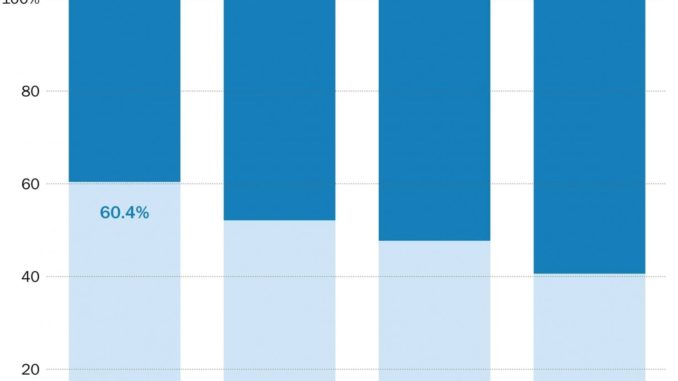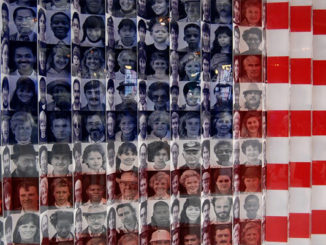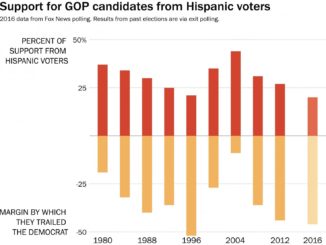
The California firm Political Data maintains a copy of the state’s voter file, which it then cleans up and provides as a service to political campaigns. In other words, the company has an ongoing record of California’s voter pool: who’s registered, when they registered, how they registered and demographic data about who they are. This allows campaigns to target specific voters with specific messages. It also allows Political Data to get a sense for how the electorate has changed over time.
And the California electorate this year has changed. Writing for Capitol Weekly, a political blog in the Golden State, Political Data’s Paul Mitchell outlined some big shifts in voter registration in the state. There’d been a big jump in registration through April of this year, Mitchell wrote — but it wasn’t uniform. The number of people registered as unaffiliated with any party grew 65 percent since Jan. 1. And that was on the low end.
In a traditional election year, a 65% growth from the same period of last year would be remarkable. But this year we are seeing a doubling of registration growth among Latinos, and a more than 150% increase for some young voters, and a near-tripling for Democrats.
The number of new Democrats registering was up 185 percent compared with the first three months of 2012. The number of voters aged 23 to 30 was up 161 percent. And, perhaps most significantly, the number of Hispanics registering was up 98 percent.
There have been a number of anecdotal reports of Hispanics seeking to become naturalized citizens in order to register to vote — and then vote against Donald Trump. The Houston Chronicle looked at this last week, finding that citizenship applications were up 15 percent between August and January compared to the year prior. There’s also a big push by Univision to get Hispanics registered to vote, with the aim of getting 3 million new voters registered.
Historically, Hispanics have the lowest turnout of any ethnic or racial group, according to Census Bureau data. Hispanics voted in 2012 at about the same rate as non-Hispanic whites did in the 2010 midterm elections.
 We were curious whether similar shifts in registration were visible in other states — particularly swing states, which California is not. Lacking full voter files in the way that Political Data has, we turned to public data published by the states.
We were curious whether similar shifts in registration were visible in other states — particularly swing states, which California is not. Lacking full voter files in the way that Political Data has, we turned to public data published by the states.
States offer voter registration data in a lot of different ways. Some don’t include party registration information. Some do it once or twice a year; others do so monthly. To draw our comparisons, we tried to get data from three periods: last fall, the beginning of 2016 and whatever was most recent. This wasn’t always possible.
It made clear that the change in registration in most swing states was mixed. In Colorado and Nevada, Democratic registration was up (as a percentage of all voters) versus the change for Republicans since the beginning of the year. In Florida and North Carolina, the Republicans had seen bigger gains. In Pennsylvania, the number of Republicans grew more than the number of Democrats since last November.
So California — a blue state that would probably be won by Hillary Clinton in November — isn’t necessarily a harbinger of universal registration rush among among Democratic voters. But two states, Georgia and North Carolina, also have data by race and ethnicity. And in each, the increase in the number of registered Hispanic voters is larger than the increase among whites or blacks. (Georgia’s numbers saw big decreases since last year as a function of updating active voter lists.)
Three useful caveats here. The first is that we still are looking at data from only three states. The second is that the number of Hispanics in Georgia and North Carolina is much smaller than other voters, meaning that the effect on outcome may be smaller. (In Georgia, the number of registered Hispanics increased from 92,000 to 101,000 between early March and late April — but there are 2.8 million white voters in the state.) And third, new voters won’t necessarily vote. The more someone votes, the more likely they are to vote in the future — people who are new voters aren’t in the habit of doing so.
It’s also too soon to give the credit for this boom to Trump. Just less than half of the Hispanics who are old enough to vote were born after 1980, thanks to the country’s Hispanic population skewing younger than any other group. Since there are a lot of new registrations among younger voters (just reaching voting age, for example, or because younger voters move more frequently and may need to re-register), this could be part of what’s happening.
For Republicans worried about the November election, though, this is a trend worth keeping an eye on. Demographics were already working against the party, which is why, after 2012, the Republican National Committee put together a plan hoping to woo Hispanic voters. Instead, they may be about to nominate a candidate who mobilizes Hispanics in the complete opposite direction.





